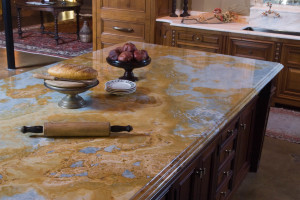Views: 2 Author: Site Editor Publish Time: 2016-06-01 Origin: Site

Today’s homeowners are interested in green building materials that have minimal impact on the environment and won’t harm the quality of the air within their home. Natural stone countertops meet both of these standards.
Granite, marble, slate and sandstone countertops are mined from solid rock. The hunks of stone are sawn into slabs using diamond-tipped blades. The slabs are often polished. There’s little else done in the manufacturing process. The amount of energy used to craft stone countertops is far less than is used in the production of laminates, engineered stone and many other types. Relatively few carbon emissions are produced in the process.
Natural stone countertops may be the last countertops you ever needs. Their average lifespan is 30+ years, and even then, they may be changed due to the changing tastes of the (new) homeowner rather than because they aren’t in good condition. With care, granite slab, granite tile or slate counters should last 50 years.
During those 30 to 50 years, laminate countertops would need to be changed several times, multiplying greenhouse gas emissions. Wood countertops – hardwood, pine, butcher block—would need to be replaced or at least resurfaced several times. Far more energy would be consumed in the process, and more waste – much of it non-recyclable—would entire landfills.
Volatile organic compounds are pollutants found in a wide range of building materials including laminate countertops. There are none in natural stone countertops, so they won’t harm your home’s indoor air quality.
Here are tips for making this project as ecofriendly as possible. First, consider using new or reclaimed natural stone tile. Used granite slabs from buildings, countertops and other installations are being cut into stone tiles for countertops. Remnants left over from cutting large stone slabs are also made into tiles. Both of these options mean no new mining and minimal energy used in production.
Secondly, use local materials. The closer the materials are produced to where you live, the less energy is used to haul them. If there is a local quarry in your area, purchasing slabs or remnants from there is a green choice.
The next step is to use a non-toxic sealer. Select one with low VOCs that won’t off-gas harmful pollutants into your home and the wider environment. Your natural stone countertop dealer can help you select the right sealer or use it in the installation.
Recycling the old countertops, if you have them, is the last step in going green in the installation of new countertops. Do what you can to prevent the materials from ending up in a landfill.
There are many materials that are said to be truly green. Most don’t pass the test when their production and long-term viability are considered. Natural stone slabs and tiles are green in addition to being durable, easy to clean and absolutely beautiful.